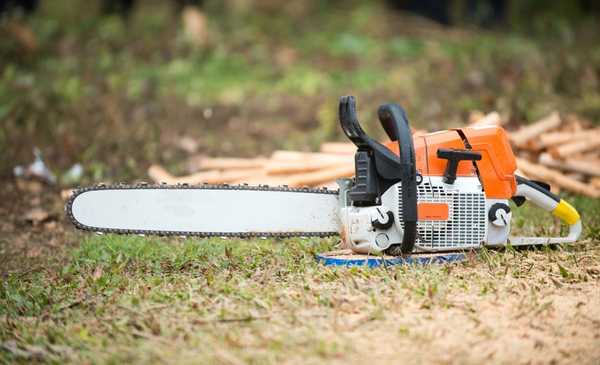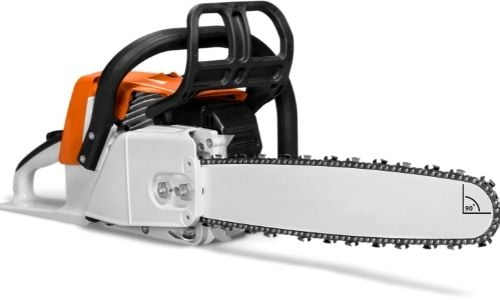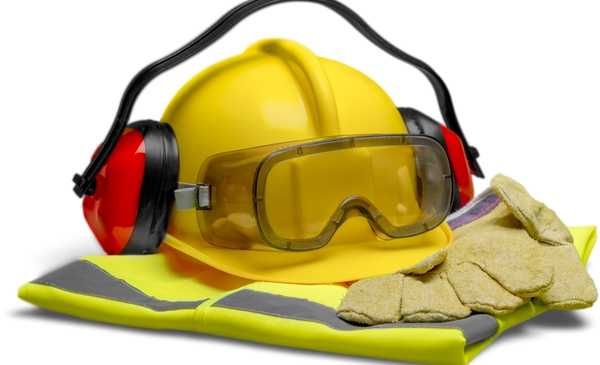Chainsaws can be used by beginners and professionals alike, but there are some key factors that should be known and adhered to in order to be safe and efficient when using a chainsaw.
In this article, we’ll cover some practical tips and tricks to help you get the most out of your chainsaw. Your first priority should be to ensure that you operate your chainsaw safely to prevent damage to the chainsaw or injury to the user.
TABLE OF CONTENTS:
Safety, safety, safety!
Although it’s tempting to just start it up and learn as you go, it’s extremely important to read the operators manual and understand the requirements for the safe use of a chainsaw. Don’t skip this bit. A chainsaw can be extremely dangerous if used incorrectly.
Different models can vary quite a lot, so even if you’ve used chainsaws before, this one may operate differently from what you may have been used to in the past. It’s vital to refresh your knowledge and familiarise yourself with the exact model you’ll be using.
Related Article: Are chainsaws dangerous?

The 10 safety features of a chainsaw
Before starting the chainsaw, there are 10 standard safety features you need to be familiar with – your chainsaw may have some or all of these:
1. Chain brake
The chain brake is an important safety feature that helps avoid kickback when operating a chainsaw.
Kickback can sometimes occur when the upper section of the end of the bar comes into contact with the log. The tip of the chainsaw bar can be ‘kicked’ upwards and towards the user by the force of the rotating chain.
The chain brake stops the chain rotation by applying a steel brake around the clutch drum. The chain brake will stop the chain immediately if kickback occurs.
2. Chain catcher
A broken chain can be a reality if chainsaws are not properly maintained. The chain catcher is there to catch the chain and protect the user if this occurs. It’s a little hook-like piece of metal which effectively stops the chain from flying off chainsaw.
3. Throttle Lock
The throttle lock is a simple mechanism to prevent accidentally activating the throttle by mistake. You must intentionally activate the throttle lock before the throttle will operate, as the throttle will only operate if the lock is engaged. This is a common safety feature on most good power tools.
4. Right Hand Guard
The right hand guard is designed to protect your hands and fingers if the chain snaps or becomes derailed during operation.
5. Top Hand Guard
Much like the right hand guard, the top hand guard is located at the top of the chainsaw, in front of the handle on the engine. These would normally be found on top-handle chainsaws and are there to protect your hand from a loose or broken chain.
6. Centrifugal Clutch
The centrifugal clutch disengages the chainsaw when the engine has been idling for a specified time. It only allows the chain to move when the throttle is fully activated and also prevents the chainsaw from doing damage if the operator gets distracted.
7. Dead-Man’s Switch
A trigger that is connected to the throttle that is depressed during use. When released, the chain brake is activated which de-activates the throttle.
8. Marked/Different Colour Caps For Fuel And Oil
Many chainsaws come with different coloured/labelled caps for fuel. Pouring diesel into a petrol chainsaw – and vice-versa – is a common occurrence with novice users. This simple feature enforces correct use of fuel.
9. Anti-Vibration Technology
There can be some fairly serious health consequences from being subjected to intense vibration over extended periods. Regular use of power tools can induce health issues due to continuous vibration.
Conditions such as ‘vibration white finger’ and ‘hand-arm vibration syndrome’ are some of the most well known. To combat this, good quality chainsaws will usually have anti-vibration systems built-in to reduce any potential strain and discomfort.
There are numerous anti-vibration systems ranging from the separation of the bar and engine from the outer casing, the use of springs and rubber bushes to absorb vibration and shock, to heated handles for promoting good blood circulation.
10. Muffler
This safety feature works by subverting dangerous exhaust fumes away from the operator. This is generally a feature used in professional gas-powered chainsaws since it is not applicable to cordless or electric chainsaws (no exhaust fumes).
All of these features are designed to help you operate a chainsaw in a safe and controlled manner, so it’s important to take the time to familiarise yourself with each one – what they do, and where they are located on the particular model you’re using.
Chainsaw kickback and how to avoid it
Kickback is the sudden jolt of the chainsaw in an upward direction. This has the potential to be extremely dangerous and is one of the most common causes of chainsaw accidents. It is therefore important to be aware of how it can occur and how to prepare for it when it happens.
When the chain gets snagged, the energy produced from the engine needs to go somewhere, resulting in a violent jolt of the chainsaw towards the user. The end of the chainsaw blade is the cutting zone that is more likely to produce kickback – this is the upper section at the top end of the chainsaw blade pictured below.

This part of the chainsaw is susceptible to pinching causing the inevitable kickback. There are also several other factors that can increase the chances of experiencing kickback, which are usually a result of poor initial setup or inadequate routine maintenance of the chainsaw.
A dull chainsaw blade for example, can increase the likelihood of kickback, since its not as capable of cutting through wood efficiently. Also if the chainsaw chain has not been tightened correctly, kickback is more likely to occur.
Related Article: Which brand of chainsaw is best?
How to avoid chainsaw kickback
To reduce the risk of chainsaw kickback, there are a few different things you can do to minimise its occurrence:
1. Read the manual
This should always be the first thing you do, especially if you have no previous experience with using chainsaws. The manual will provide everything you need to use your chainsaw in a safe way.
2. Check the chain brake before you start
The chain brake is designed to stop the chainsaw chain immediately if a fault occurs. It also enables the user to change position without turning off the whole chainsaw, but it comes in especially handy in the event of kickback.
This device has prevented many injuries since its inclusion as a standard safety feature in chainsaws.
3. Use low-kickback chains
Low profile or semi-chisel chains are great for novice chainsaw users since they are less likely to result in kickback. Conversely, a full-chisel chain has square-cornered cutting teeth which cut through wood quicker, but the downside is a higher risk of kickback.
It’s important to choose the correct type of chain for your specific requirements and capabilities.
4. Use a sharp chain
Dull chains are a major cause of kickback because the teeth are not able to cut through wood efficiently. This causes the chain to get easily stuck which can cause kickback.
5. Stay out of the kickback zone
As mentioned previously, you need to avoid the kickback zone when you are cutting, and always use the correct part of the blade. This will greatly reduce the chance of kickback.
Handling your chainsaw safely
To ensure a safe experience, ALWAYS keep a firm grip on the chainsaw with both hands. This provides the optimum support in the event of kickback. Concentration and awareness when operating a chainsaw is absolutely essential to remain safe and injury-free.
Avoid cutting materials other than wood
A chainsaw is designed to cut natural wood. Cutting certain timber materials such as pallets, or wooden items littered with nails or screws can very quickly damage the chain.
Before any cutting, always ensure that the material you’re working with is free of any potentially unsafe material.

Additional chainsaw safety tips
Use the right tool for the job
Chainsaws are highly versatile and effective for cutting big logs, but they shouldn’t be used unless absolutely necessary. Don’t use a chainsaw to cut firewood down to size to fit your fireplace, instead use a log splitter or splitting axe for the job.
These will do the job perfectly. Most manufacturers don’t recommend using a chainsaw to split firewood, as loose logs are prone to moving or splintering during cutting.
Avoid using your chainsaw around or in the dirt. When a chainsaw chain (while operating) comes into contact with the ground it blunts the chain very quickly.
Keep the chain clean and sharp
A blunt chain will need to be sharpened or replaced prior to further cutting. The easiest way to avoid a blunt chain is to cut with good technique, avoid using your chainsaw around or in the dirt (tree roots) and carry out the routine maintenance advised by the manufacturer.
In addition to this, avoid damage to your chainsaw chain by always engaging the chain brake before setting the chainsaw down – this prevents the chain spinning and catching on surrounding material.
Be safe when moving around with a chainsaw
When you move around with the saw running tore-position yourself, activate the chain brake and carry the saw securely by holding the front handle. Even better, switch off the chainsaw completely to minimise any risk.
Check your fuel
When refuelling, be sure to use the recommended 2-stroke fuel mix as advised by the manufacturer. You should not attempt to run a chainsaw with regular fuel.
Related Article: Do chainsaws take regular or mixed gas?
Lubricate the chain regularly
To keep your chainsaw running smoothly and efficiently, you should ensure your chain bar is regularly oiled/lubricated. Make sure to always top up the chain oil tank when refuelling your chainsaw.
If the chain is not adequately lubricated with chain bar oil it will become blunt very quickly causing excessive wear to your chain and engine.
Cut the appropriate size of wood for your saw
Typically, a chainsaw can cut logs a couple of inches shorter than the bar length. Any bigger than this and you’re working in the kickback zone. Always cut wood in accordance with your chainsaw’s safe working parameters.
Wear the correct safety gear (PPE)
Head, hand, ear, and eye protection is an absolute necessity when operating a chainsaw. Chainsaw chaps are also a very good idea which will save your thighs in the event any slippage when cutting.
In addition to this, always wear steel toe-cap boots and some heavy-duty overalls to protect against scrapes and scratches when working.
Things you might need…
Conclusion
These practical tips and tricks will help you get the most out of your chainsaw. Your first priority should be to ensure that you operate your chainsaw safely to prevent damage to the chainsaw or injury to the user.
Compliance with these tips and tricks will always ensure your chainsaw is ready for action!




Leave a Reply